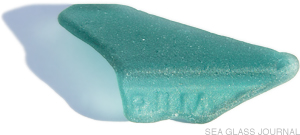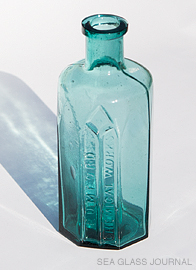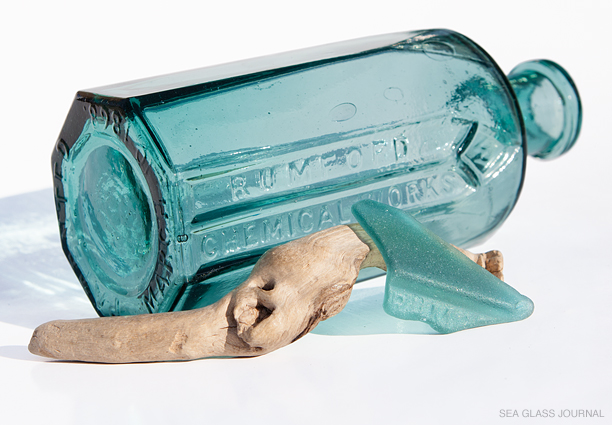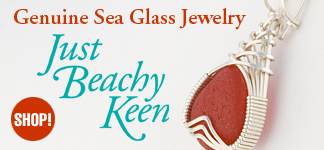The Sea Glass Shard of the Month: November 2014
Rumford Bottle Sea Glass Segment

See MORE IMAGES
Sea Glass Specifications:
Color: Teal
Max Length: 47.6 mm (1.875")
Max Width: 27.9 mm (1.10")
Weight: 6.5 grams (0.23 oz)
Estimated Age: 100 to 140 years old
The month of November features a teal colored bottle shard found on the shores of Rhode Island. Mixtures using oxides of cobalt (blue) with iron or chromium (green) were used to produce the blue-green hue of teal. This color was generally uncommon in machine-made bottles and generally indicate a 19th or very early 20th century manufactured container.

The "Rumford Bottle," as referred to by bottle collectors, in the typical teal blue color and eight-sided design.
LARGER IMAGE
Facts of Interest
The Rumford Company produced many other products such as the famous Rumford's Baking Powder and Rumford's Yeast Powder which were actually the same product under two different names.
The name Rumford was a reference to one of the original founders, Professor Eben. N. Horsford, who held the chairmanship as Rumford Professor at Harvard University in Massachusetts from 1847 until 1863.
 |
This was taken to relieve mental and nervous exhaustion and other ailments. |
 |
Sodas, mineral waters, porters beer and ales were the usual types of bottles made with this teal color and were commonly of a round and thicker cross section. These types of bottles had to had to withstand the rigors of repeated handling and rebottling. Upon inspection of this specimen we notice a few features that help indicate its origins. First is that it comes from a bottle with fairly thin sides of a multiple, flat-sided design. Another feature are the letters R, U and M — the remnants of a more extensive embossing. These features taken together indicate this sea glass specimen came from a fairly common but old bottle from the Rumford Chemical Works.
The Rumford Chemical Works, established in East Providence, RI in 1859 manufactured chemicals on a mass scale. The most popular chemical produced by the firm was Horsford's Acid Phosphate. This tonic concentrate was patented on March 10, 1868 and was continually manufactured until the early 1940's. When a teaspoon of the product was mixed with a glass of cold water and sugar, the result was a "... delicious and refreshing drink" similar to the present day lemon-lime drinks. This tonic was taken to relieve mental and nervous exhaustion and cured other ailments. It proved to be so popular in the United States, that it was exported to many foreign countries. [1]
The earliest bottles containing this tonic were made of aqua colored glass but later in the 1880s were made with the teal color. In the early 1900s, when machine made bottles became common, the teal color was dropped in favor of a very light green and brilliant green hues. The teal colored bottles, being the most common color used in the manufacturing of this product, along with the unusual eight-sided design became know by bottle collectors as "The Rumford Bottle." The teal blue color can be found in either light or dark hues, and some are found in teal green. [2]
While in many cases the origins of a sea glass shard may be difficult to access, with only general assumptions being made, this sea glass shard has maintained many of its production features that indicate its original source, a Rumford Bottle from a blown-in-mold production method from the late 19th to early 20th Century.
REFERENCES:
1. http://www.littlerhodybottleclub.org/research/rumford.html
2. Ibid.

Keep up-to-date on all things sea glass... "Like Us" on Facebook!
Sea Glass Journal on Facebook






